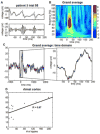High-frequency neural activity and human cognition: past, present and possible future of intracranial EEG research
- PMID: 22750156
- PMCID: PMC3980670
- DOI: 10.1016/j.pneurobio.2012.06.008
High-frequency neural activity and human cognition: past, present and possible future of intracranial EEG research
Abstract
Human intracranial EEG (iEEG) recordings are primarily performed in epileptic patients for presurgical mapping. When patients perform cognitive tasks, iEEG signals reveal high-frequency neural activities (HFAs, between around 40 Hz and 150 Hz) with exquisite anatomical, functional and temporal specificity. Such HFAs were originally interpreted in the context of perceptual or motor binding, in line with animal studies on gamma-band ('40 Hz') neural synchronization. Today, our understanding of HFA has evolved into a more general index of cortical processing: task-induced HFA reveals, with excellent spatial and time resolution, the participation of local neural ensembles in the task-at-hand, and perhaps the neural communication mechanisms allowing them to do so. This review promotes the claim that studying HFA with iEEG provides insights into the neural bases of cognition that cannot be derived as easily from other approaches, such as fMRI. We provide a series of examples supporting that claim, drawn from studies on memory, language and default-mode networks, and successful attempts of real-time functional mapping. These examples are followed by several guidelines for HFA research, intended for new groups interested by this approach. Overall, iEEG research on HFA should play an increasing role in cognitive neuroscience in humans, because it can be explicitly linked to basic research in animals. We conclude by discussing the future evolution of this field, which might expand that role even further, for instance through the use of multi-scale electrodes and the fusion of iEEG with MEG and fMRI.
Copyright © 2012 Elsevier Ltd. All rights reserved.
Figures






Similar articles
-
Modeling brain activation patterns for the default and cognitive states.Neuroimage. 2009 Apr 1;45(2):298-311. doi: 10.1016/j.neuroimage.2008.11.036. Epub 2008 Dec 11. Neuroimage. 2009. PMID: 19121401
-
Recording human electrocorticographic (ECoG) signals for neuroscientific research and real-time functional cortical mapping.J Vis Exp. 2012 Jun 26;(64):3993. doi: 10.3791/3993. J Vis Exp. 2012. PMID: 22782131 Free PMC article.
-
Mapping of the neuronal networks of human cortical brain functions.Adv Tech Stand Neurosurg. 2003;28:91-142. doi: 10.1007/978-3-7091-0641-9_2. Adv Tech Stand Neurosurg. 2003. PMID: 12627809 Review.
-
EEG signals respond differently to idea generation, idea evolution and evaluation in a loosely controlled creativity experiment.Sci Rep. 2021 Jan 22;11(1):2119. doi: 10.1038/s41598-021-81655-0. Sci Rep. 2021. PMID: 33483583 Free PMC article.
-
High frequency oscillations in the intact brain.Prog Neurobiol. 2012 Sep;98(3):241-9. doi: 10.1016/j.pneurobio.2012.02.004. Epub 2012 Mar 17. Prog Neurobiol. 2012. PMID: 22449727 Free PMC article. Review.
Cited by
-
Assessing the coupling between local neural activity and global connectivity fluctuations: Application to human intracranial electroencephalography during a cognitive task.Hum Brain Mapp. 2023 Feb 15;44(3):1173-1192. doi: 10.1002/hbm.26150. Epub 2022 Nov 27. Hum Brain Mapp. 2023. PMID: 36437716 Free PMC article.
-
Intracranial recordings reveal transient response dynamics during information maintenance in human cerebral cortex.Hum Brain Mapp. 2015 Oct;36(10):3988-4003. doi: 10.1002/hbm.22892. Epub 2015 Jul 3. Hum Brain Mapp. 2015. PMID: 26147431 Free PMC article.
-
Category-Selectivity in Human Visual Cortex Follows Cortical Topology: A Grouped icEEG Study.PLoS One. 2016 Jun 7;11(6):e0157109. doi: 10.1371/journal.pone.0157109. eCollection 2016. PLoS One. 2016. PMID: 27272936 Free PMC article.
-
Steady state evoked potential (SSEP) responses in the primary and secondary somatosensory cortices of anesthetized cats: Nonlinearity characterized by harmonic and intermodulation frequencies.PLoS One. 2021 Mar 9;16(3):e0240147. doi: 10.1371/journal.pone.0240147. eCollection 2021. PLoS One. 2021. PMID: 33690648 Free PMC article.
-
Significance of event related causality (ERC) in eloquent neural networks.Neural Netw. 2022 May;149:204-216. doi: 10.1016/j.neunet.2022.02.002. Epub 2022 Feb 18. Neural Netw. 2022. PMID: 35248810 Free PMC article.
References
-
- Allison T, McCarthy G, Nobre A, Puce A, Belger A. Human extrastriate visual cortex and the perception of faces, words, numbers, and colors. Cereb Cortex. 1994;4:544–554. - PubMed
-
- Anastassiou CA, Perin R, Markram H, Koch C. Ephaptic coupling of cortical neurons. Nat Neurosci. 2011;14(2):217–23. - PubMed
-
- Aoki F, Fetz EE, Shupe L, Lettich E, Ojemann GA. Increased gamma-range activity in human sensorimotor cortex during performance of visuomotor tasks. Clin Neurophysiol. 1999;110:524–537. - PubMed
-
- Axmacher N, Cohen MX, Fell J, Haupt S, Dümpelmann M, Elger CE, Schlaepfer TE, Lenartz D, Sturm V, Ranganath C. Intracranial EEG correlates of expectancy and memory formation in the human hippocampus and nucleus accumbens. Neuron. 2010b;65(4):541–9. - PubMed
-
- Axmacher N, Elger CE, Fell J. Ripples in the medial temporal lobe are relevant for human memory consolidation. Brain. 2008;131:1806–1817. - PubMed
Publication types
MeSH terms
Grants and funding
LinkOut - more resources
Full Text Sources
Other Literature Sources
Medical
Miscellaneous

